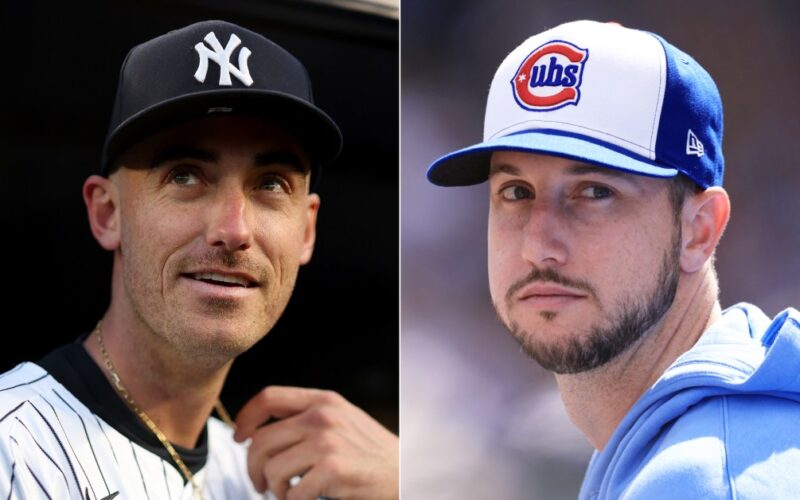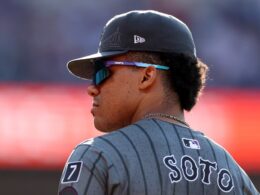With the Cubs’ season coming to a close over the weekend, it’s possible that Kyle Tucker’s time on the North Side is over.
The outfielder is set to become baseball’s top free agent this offseason after a blockbuster deal with Houston sent him to Chicago last winter. With Tucker expected to sign a deal worth hundreds of millions of dollars — somewhere around $350-$400 million is still feasible after an uneven season — it wouldn’t be a shock to see the Cubs balk at the finances required for a reunion.
“We’ll see what happens,” Tucker told reporters after the Cubs were eliminated by the Brewers in the NLDS. “I don’t know what the future’s going to hold.”
The Yankees are one of a few high-rollers who should pursue the 28-year-old Tucker, as they expressed interest in him last offseason before the rival Astros struck a deal with Chicago. Just a few days later, the Cubs sent fellow outfielder Cody Bellinger to the Yankees in a salary dump.
The sequence of events worked out well for the Yankees, as Bellinger went on to have a stellar season. The campaign put him in position to decline a $25 million player option and become a free agent this winter.
However, Bellinger said he would “absolutely” love to come back after the Yankees were eliminated in the ALDS.
“I had an unbelievable time putting on this uniform,” added the 30-year-old, whose father, Clay, played for the Yanks from 1999-2001. “Yankee Stadium, the fans, the organization, the culture that these guys have created in this locker room, it really is special. It’s such a fun group. It was a fun group to be a part of.”
While Bellinger fit in rather well with the Yankees, they could once again prioritize exploring Tucker’s market first.
With that in mind, let’s take a look at how the two players compare…
OFFENSE: ADVANTAGE TUCKER
Bellinger, a key piece in the Yankees’ post-Juan Soto pivot, shined while primarily hitting third behind Aaron Judge, slashing .272/.334/.480 with 29 home runs, 98 RBI, 13 stolen bases and a 125 wRC+ over 152 games. Long-held expectations that his left-handed stroke would thrive at Yankee Stadium proved true, and his ability to tailor his approach to the situation stood out in the Bombers’ slug-centric lineup.
That said, Tucker, also a left-handed hitter with more power, is the better offensive player.
While his 2025 season featured plenty of ups and downs and some injuries — he played through a hairline fracture in his right hand and missed almost all of September with a strained left calf — Tucker still hit .266/.377/.464 with 22 home runs, 73 RBI, 25 stolen bases and a 136 wRC+ over 136 games. Not bad for an off year.
Tucker has also been the more consistent hitter, posting an .878 OPS and a 143 wRC+ with 134 homers since 2021, his first full season in the majors. Bellinger, who won the National League’s MVP Award in 2019 before injuries contributed to some down seasons, has a .746 OPS, a 105 wRC+ and 102 dingers over that same span.
DEFENSE: ADVANTAGE BELLINGER
While Tucker is the superior hitter, Bellinger is the better defender. Each has a Gold Glove to their name, but Bellinger’s metrics are far more favorable.
In 2025, Bellinger totaled six Outs Above Average and 12 Defensive Runs Saved between all three outfield positions. Tucker had -2 OAA and -1 DRS while playing right, the only position he’s manned since 2021.
Center field was Bellinger’s worst position in 2025 (-1 OAA), but he gives the Yankees an option there with Trent Grisham hitting free agency and the club still figuring out how youngsters Jasson Domínguez and Spencer Jones fit into its immediate plans.
Signing Tucker would mean putting him in Yankee Stadium’s expansive left field or shifting Aaron Judge out of right. Neither situation is ideal defensively.
Bellinger is also capable of playing first base, giving the Yankees some versatility with Ben Rice looking like the future of the position but still growing as a defender.
POSTSEASON PERFORMANCE: IT’S A WASH
With plenty of postseason experience between them, Tucker and Bellinger are essentially equals when it comes to October performance. Each has won a championship, and neither has been particularly good on the whole.
Tucker has hit .233 with a .692 OPS, nine homers and 29 RBI over 72 playoff games. Bellinger is a .211 hitter with a .660 OPS, 10 home runs and 37 RBI over 76 playoff games.
This postseason, Tucker hit .259 with a .745 OPS, one home run and one RBI over eight games. Bellinger hit .214 with a .651 OPS, one home run and four RBI over seven games.
CLUBHOUSE FIT: ADVANTAGE BELLINGER
Bellinger has the advantage here, just because Tucker has never been a member of the Yankees.
But Bellinger has more than just a default working in his favor, as he clicked well in the Yankees’ clubhouse, worked with Domínguez defensively, and earned adoration from Aaron Boone throughout the season.
“On top of how good a player he’s been between the lines, he’s also just a great teammate and guy to have,” Boone said in mid-September. “There’s no drama. He’s kind of blue-collar-ish. He knows the grind, appreciates the grind, knows how to do it. There’s some humility to him, like he’s self-deprecating.
“He’s just good at it.”
While personality and vibes won’t be near the top of considerations here, there is something to be said of Bellinger’s off-field fit, experience in the New York market, and general embrace of being a Yankee.
COST: ADVANTAGE BELLINGER
Finances will be a stronger consideration. Once again, Bellinger has the advantage.
While it’s unclear exactly what the Scott Boras client is looking for in a long-term deal, he should easily exceed the three-year, $80 million, option-heavy deal he signed with the Cubs before the 2024 season. One of the best bats on the market behind Tucker, Bellinger is expected to crack nine figures. The fact that the Yankees can’t extend him a qualifying offer will make him attractive to a wider range of suitors, too, which could drive his bidding up.
Of course, the Yankees can afford the pricier Tucker. After all, they had a $760 million offer out to Soto last winter, though he is younger and more of a commercial draw.
LONG-TERM PLANNING: ADVANTAGE TUCKER
Given his age and overall consistency, Tucker is the better option when thinking about the Yankees’ long-term future.
Keep in mind that Judge will be 34 next April. While he hasn’t shown any signs of slowing down after putting together another MVP-worthy season, it is fair to wonder how many otherworldly years he has left. Life after Judge’s prime is exactly why the Yanks threw so much money at Soto, and a reason for Tucker to edge out Bellinger in this hypothetical head-to-head.
Over the course of a long-term deal that would presumably coincide with at least a relative decline in Judge’s production, Tucker projects as the preferred bat in the middle of the Yankees’ lineup.
It’s also worth noting that the next few free agent classes may be short on elite offensive talent, as Orioles shortstop Gunnar Henderson could be the next young, top-shelf hitter to land on the open market. That wouldn’t happen until after the 2028 season.








